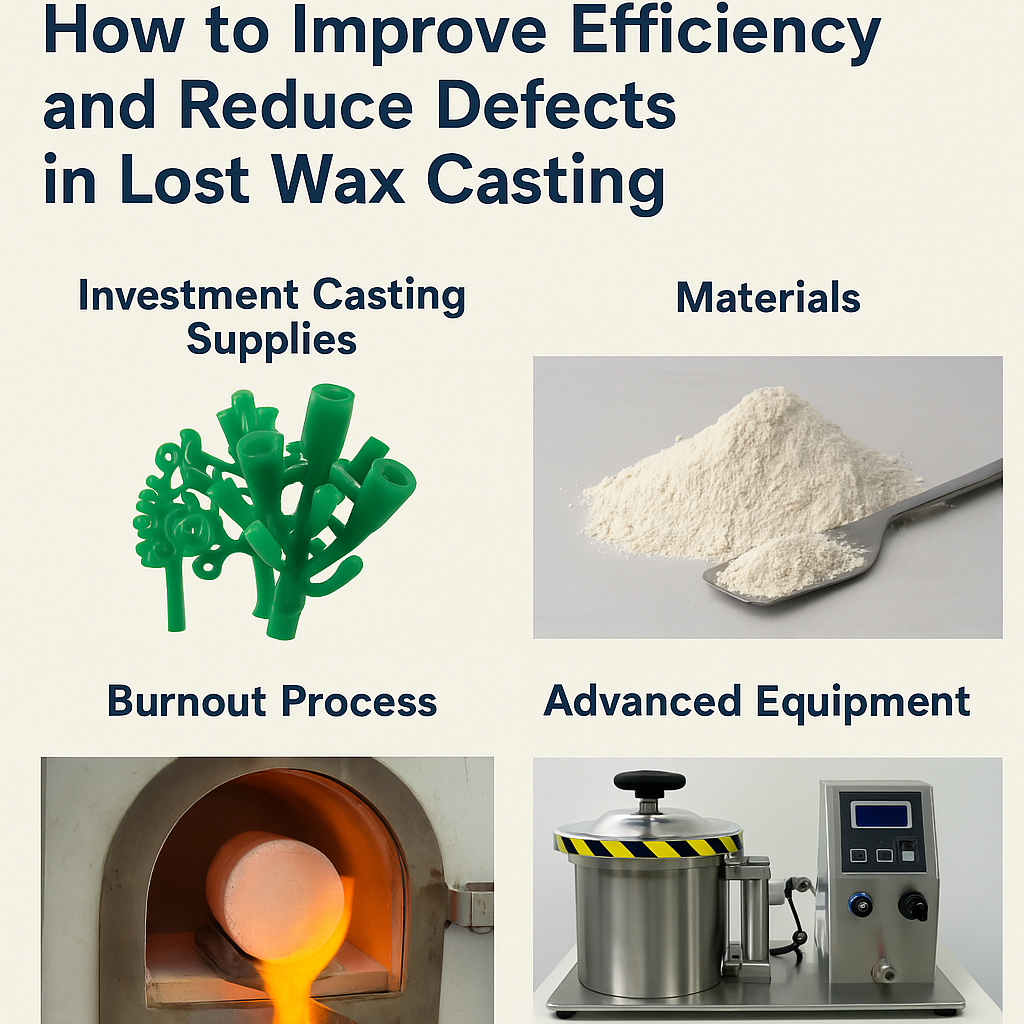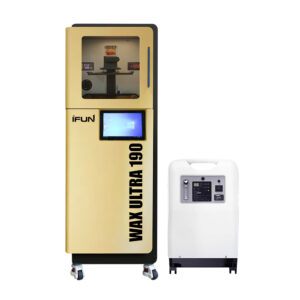Investment casting, also known as lost wax casting, is a highly precise manufacturing process used in industries ranging from jewelry to aerospace. While having the right investment casting supplies is essential, achieving optimal efficiency and minimizing defects requires a deeper understanding of the process, materials, and equipment. This article explores strategies to enhance production efficiency, reduce defects, and improve overall casting quality.

Common Challenges in Lost Wax Casting
1. Defects in Investment Casting
Despite its precision, lost wax casting is susceptible to defects, including:
- Porosity – Caused by trapped air or improper metal cooling.
- Shrinkage – Due to uneven metal solidification.
- Surface Roughness – Resulting from poor-quality wax or investment materials.
- Incomplete Fill – Occurs when molten metal does not fully occupy the mold.
2. Inefficiencies in the Process
- Long Production Cycles – Due to extended wax burnout and metal cooling times.
- Material Waste – Excessive wax and investment material loss.
- High Energy Consumption – From furnaces and kilns.
How to Improve Efficiency and Reduce Defects
1. Choosing the Right Wax for Lost Wax Casting
The quality of the wax directly affects the final casting. Selecting the correct wax type ensures better mold precision and fewer defects.
- Low-Expansion Wax – Reduces shrinkage and cracking.
- High-Detail Wax – Ideal for intricate designs in jewelry and fine metalwork.
- Recyclable Wax – Minimizes material waste and lowers production costs.
2. Optimizing Investment Materials
Investment materials must be chosen based on metal type and application.
- Plaster-Based Investment – Best for gold, silver, and low-temperature alloys.
- Silica-Based Investment – Provides superior heat resistance for industrial and dental casting.
- Ceramic Investment – Ideal for high-temperature alloys like bronze and titanium.
3. Enhancing the Burnout Process
A proper burnout cycle ensures a clean mold cavity and reduces casting defects.
- Gradual Heating Ramps – Prevents cracking in the investment mold.
- Adequate Ventilation – Removes wax efficiently to avoid gas porosity.
- Controlled Temperature Profiles – Ensures complete wax removal while preserving mold integrity.
4. Using Advanced Casting Equipment
Investing in modern casting machines can significantly improve efficiency and consistency.
- Vacuum Casting Machines – Reduce air entrapment and improve metal flow.
- Centrifugal Casting Systems – Ensure uniform metal distribution.
- Induction Melting Furnaces – Provide precise temperature control and reduce oxidation.
Case Studies: How Industry Leaders Optimize Investment Casting
Jewelry Manufacturing: Reducing Shrinkage and Enhancing Surface Finish
We once worked with a high-end jewelry brand that had been facing a particularly frustrating issue: shrinkage defects and inconsistent surface finishes. They were seeing problems especially in their more intricate designs, where shrinkage cracks would form, and the surface finishes often required heavy post-processing. This not only added to the labor but also led to a lot of material wastage.
Problem Discovery and Challenges:
At first, the designers and production team didn’t realize the full scope of the issue. They thought it was just a “normal” part of the casting process. It wasn’t until a large batch order was produced that they noticed the inconsistencies. The dimensional differences between pieces were minor but noticeable, and some designs even had visible cracks. What made matters worse was that the finishing process was so labor-intensive—polishing required much more effort than anticipated, and even then, the result wasn’t perfect. After some investigation, we discovered that the core problem lay in the wax material they were using. It had an unstable expansion rate, which was causing the shrinkage during cooling, especially in the fine details.
Solution Implementation:
Wax Pattern Selection: First, we recommended they switch to a low-expansion wax. This type of wax has a much lower coefficient of expansion, meaning it would shrink less during cooling. This not only minimized dimensional issues but also prevented cracks in the more intricate designs. We tested a few different wax formulations, and after several rounds of trial and error, we found the perfect balance for their complex patterns.
Mold Formula Optimization: Next, we adjusted their investment mold formula. The original mold material wasn’t holding up well under the high temperatures, leading to stress cracks. We added specific minerals to improve the mold’s thermal stability, which helped reduce cracking during the casting process. This was a crucial step, as the molds needed to withstand the high temperatures without compromising the structural integrity of the casting.
Vacuum-Assisted Casting: To further improve the process, we introduced vacuum-assisted casting. This technique helped eliminate trapped air and gas porosity in the mold. With vacuum pressure, the molten metal was able to fill the mold more thoroughly, which not only improved the surface quality but also made the castings denser and more detailed. We worked closely with their team to fine-tune the vacuum settings—adjusting the vacuum pressure and timing to get optimal results.
Outcome:
The results were impressive. Shrinkage defects decreased by around 40%, and the surface finish drastically improved. This reduced the need for heavy post-processing like polishing and refining, which in turn saved time and money. The most rewarding part was seeing their complex designs coming out of the mold almost flawless, with fewer defects and a smoother surface. Overall, they were able to reduce material waste significantly and increase production efficiency.
Aerospace Component Production: Improving Thermal Resistance and Reducing Defects
An aerospace manufacturer producing high-performance turbine components struggled with defects caused by thermal expansion and incomplete mold fills. To improve casting integrity, they switched to ceramic investment materials and optimized their burnout cycle.
Implementation Process:
- Material Change: The company adopted ceramic investment materials with high thermal resistance, ensuring dimensional stability even at extreme temperatures.
- Enhanced Burnout Process: A controlled burnout cycle was implemented with gradual heating ramps, allowing for complete wax removal without micro-cracking the mold.
- Induction Melting Integration: They introduced an induction melting furnace, providing precise temperature control and reducing oxidation during metal pouring.
- Outcome: Defect rates dropped by 20%, and the improved mold durability allowed for more complex geometries to be cast with higher accuracy.
Frequently Asked Questions (FAQs)
1. How can I minimize porosity in investment casting?
Using vacuum casting, controlled cooling rates, and high-quality investment materials can significantly reduce porosity.
2. What is the best investment material for high-temperature metals?
Ceramic-based investments offer superior heat resistance for alloys like titanium and bronze.
3. How does 3D printing impact lost wax casting?
3D-printed wax patterns allow for more complex geometries, improved precision, and reduced production time.
Conclusion
Optimizing lost wax casting goes beyond simply acquiring the right investment casting supplies. By selecting superior materials, improving process efficiency, and leveraging advanced equipment, manufacturers can significantly reduce defects, minimize waste, and enhance overall production quality. For the best results, continually assess and refine your casting methods to meet evolving industry standards.
Key factors and optimization of 3D printing lost wax casting

